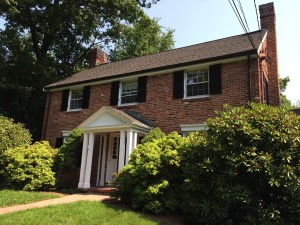![]() Senate Control Could Come Down To Whole Foods vs. Cracker Barrel | FiveThirtyEight
Senate Control Could Come Down To Whole Foods vs. Cracker Barrel | FiveThirtyEight Entertaining analysis showing, perhaps, only that marketers are better at understanding the country’s political segmentation than political campaign planners are.
Entertaining analysis showing, perhaps, only that marketers are better at understanding the country’s political segmentation than political campaign planners are.![]() Aunt Maria’s Vermont Maple Sugar Pie, 1945 – A Vintage Pie Recipe Test – The Mid-Century Menu
Aunt Maria’s Vermont Maple Sugar Pie, 1945 – A Vintage Pie Recipe Test – The Mid-Century Menu![]() The Questa Project | I Love Typography
The Questa Project | I Love Typography Seriously cool new font family, worth checking out.
Seriously cool new font family, worth checking out.
Month: October 2014
New house, new history
The fence in front of our house is more than 150 years old, but the house itself is only 67 years old.
That was one of the surprises I had when researching the history of our new house. It sits on a main thoroughfare of Lexington, down the street from a church, meeting hall, and old village grocery store, and I always wondered how it was that there was relatively new construction here. It turns out the answer was simple: they moved the old house.
On our lot in 1716, Stephen Robbins built his homestead, and the Robbins family lived here through the mid-19th century. Around 1850, his family built the fence in front of the house, the one historical structure on the property. It’s sturdy, built of wrought iron and granite posts, and it isn’t going anywhere.
Unlike the Robbins house. After a long history (among other things, the house was apparently a station on the Underground Railroad), the house moved on—literally. In the 1940s, Helen Potter bought the place for $500, then spent more than $3,000 to move it up the street, where it still stands today. In its place, the Cataldo family built our brick Colonial, completing it in 1947.
The Cataldos have been in town since the early 20th century. There’s a good oral history by one of the brothers that talks about the early days of the family, including Anthony Cataldo, who founded the Depository Trust Company of Medford and who purchased the depot building for a bank branch when the Lexington West Cambridge Railroad stopped running.
At some point before 1993 the property changed hands, and the biggest alteration was made: a subdivision of the property (and maybe the adjacent property) resulted in the creation of a cul-de-sac and three old-looking modern Colonial houses that surrounded it. Aside from the demolition of an old barn that once stood on a corner of our property, the biggest change to our house was a remodel that left us with gold fixtures in the bathrooms.
Fast forward twenty years. After a few owners, the house was purchased by a nearby school eight years ago and became a rental property. When they realized they needed cash for renovation projects, the house went on the market and we snapped it up. Now comes the fun part of its history: making it ours.
New house, new start
The Jarrett House North has moved. I don’t mean this blog, though given my relative silence here for the last too-long-to-count you’d be forgiven for thinking all the action was going on elsewhere. No, I mean our physical house. Ten years to the day after buying our first Massachusetts home, we became the owners of this 1947 Colonial in Lexington. After ten years in a Cape, I still can’t get over all the space. I mean, we certainly made that little Cape as spacious as we could. But it’s no match for center hall, full second floor, full attic. Even with only a half-finished basement it’s still a lot of room. So of course, we’re still in boxes despite having moved six weeks ago. But we’re getting used to the place and the neighborhood. And what a neighborhood! East Lexington was a separate village once upon a time and we’re right at the center of it all. I’ll post a little about our neighboring architecture soon. And the grounds are astonishing — after having to cut down a bunch of diseased trees at the old house, to have a bunch of healthy horse chestnut trees, maples, a gorgeous plane tree, and even what I think might be an apple tree is a fantastic blessing. So even on a rainy day, I can sit here and look out the window and say: we lucked out.

